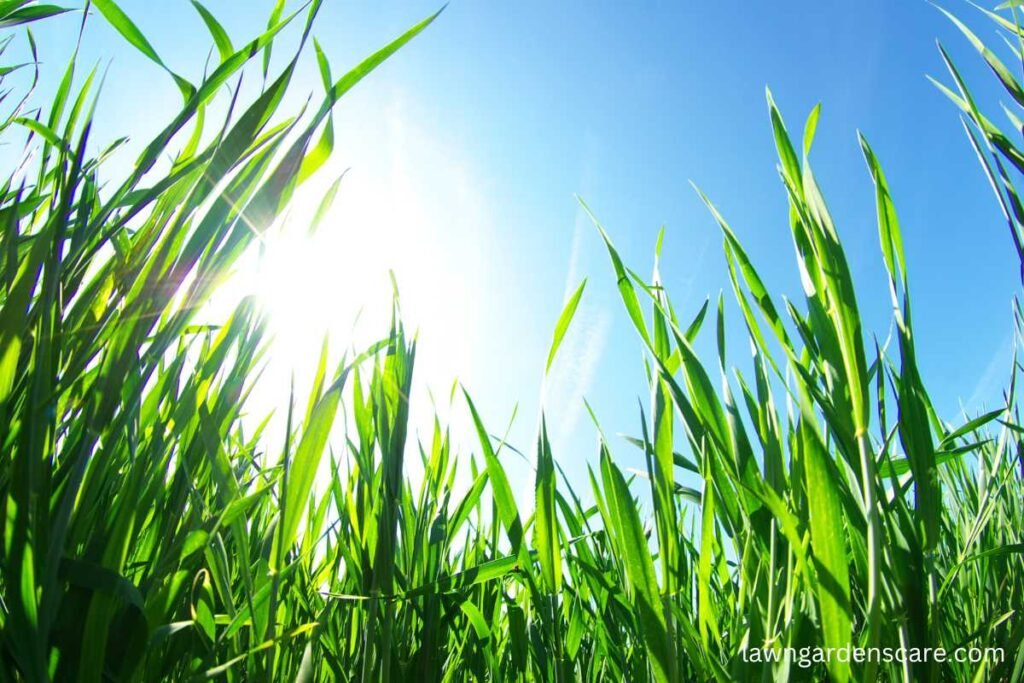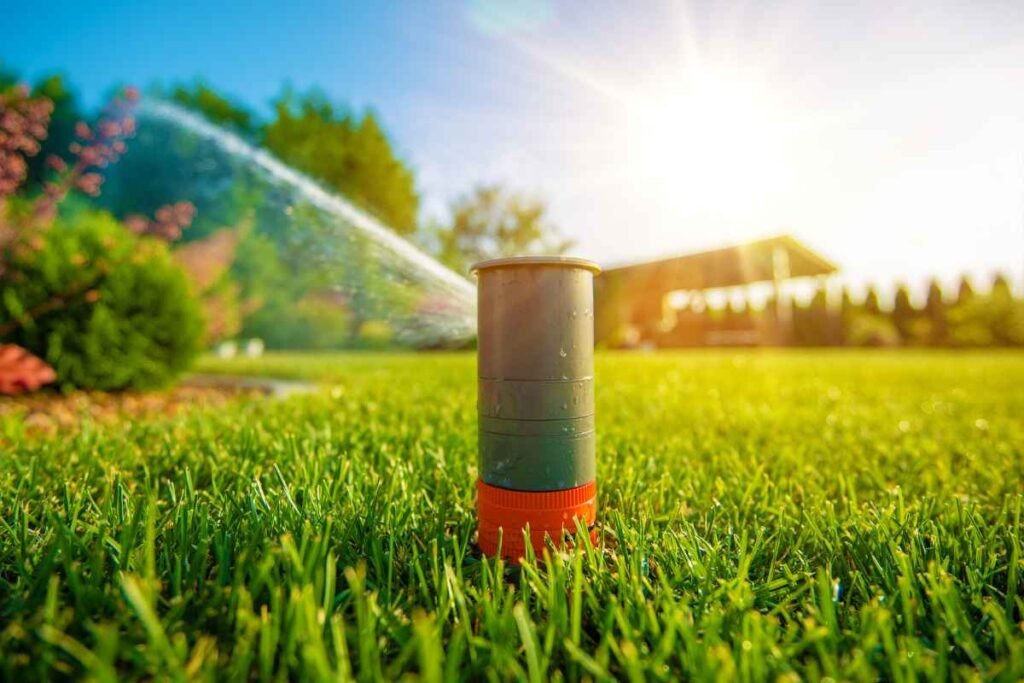One winter morning, my neighbor Jake discovered gray patches overtaking his lawn—snow mold had struck. Armed with expert tips and better fall prep, he treated the damage and planned smarter care. By spring, his lawn was lush again. Want to know Jake’s secrets to a healthy winter lawn? Read on common winter lawn diseases to protect your yard year-round.
5 Common Winter Lawn Diseases: Guides and Best Fungicides
Winter can stress lawns and create favorable conditions for fungal diseases. This detailed guide will help you to identify, prevent, and treat common winter lawn diseases like my neighbor Jake.
1. Snow Mold (Gray and Pink)
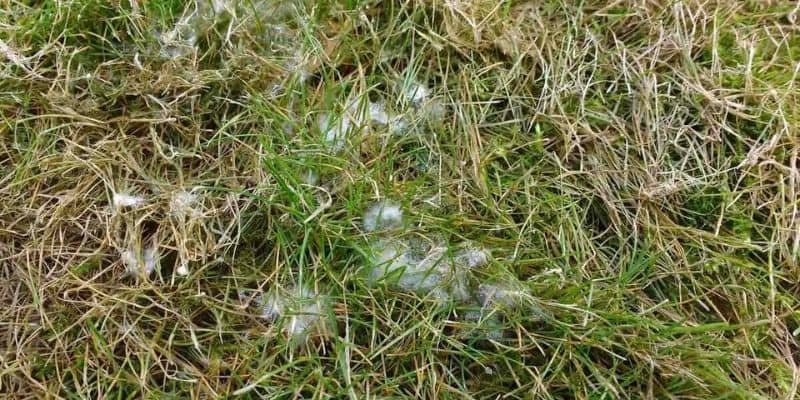
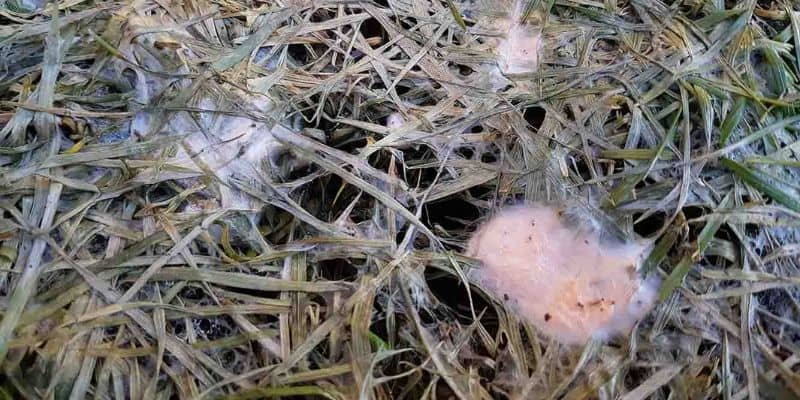
Causes:
- Gray snow mold is caused by the Typhula fungus, while pink snow mold is caused by Microdochium nivale.
- Prolonged snow cover, wet conditions, and late fall over-fertilization promote these diseases.
- Excessive thatch and compacted soil also increase susceptibility.
Symptoms:
- Gray Snow Mold:
- Circular, grayish-white patches (2-3 feet in diameter) appear as snow melts.
- Patches may have a crusty appearance in severe cases.
- Pink Snow Mold:
- Smaller, pinkish patches (6-12 inches) that thrive in wet, cold conditions.
- Pink coloration often appears at the edges of affected areas.
Prevention:
- Thatch Management: Aerate or dethatch in the fall to prevent excessive organic buildup.
- Mowing Height: Gradually lower the mowing height before winter to prevent matting.
- Fertilizer Timing: Apply nitrogen fertilizer no later than early fall to avoid stimulating late-season growth.
Treatment:
- Rake affected areas in early spring to allow air circulation and promote new growth.
- Apply fungicides containing active ingredients like azoxystrobin, propiconazole, or thiophanate-methyl in late fall or as snow melts.
Recommended Fungicides:
- Scotts® DiseaseEx™ Lawn Fungicide
- Active Ingredient: Azoxystrobin 0.31%
- Application:
- Preventative Rate: Apply 2.25 lbs per 1,000 sq. ft.
- Curative Rate: Apply 3.75 lbs per 1,000 sq. ft.
- Method: Use a broadcast or drop spreader for even distribution.
- Frequency: Reapply every 14-28 days as needed.
- Note: Starts working within 24 hours and provides up to 4 weeks of control.
Pillar® G Intrinsic® Granular Fungicide
- Active Ingredients: Pyraclostrobin and Triticonazole
- Application:
- Rate: Apply 3 lbs per 1,000 sq. ft.
- Method: Use a properly calibrated broadcast spreader.
- Frequency: Apply every 14-28 days, not exceeding 5 applications per year.
- Note: Effective against a broad spectrum of diseases, including snow molds.
2. Fusarium Patch (Microdochium Patch)
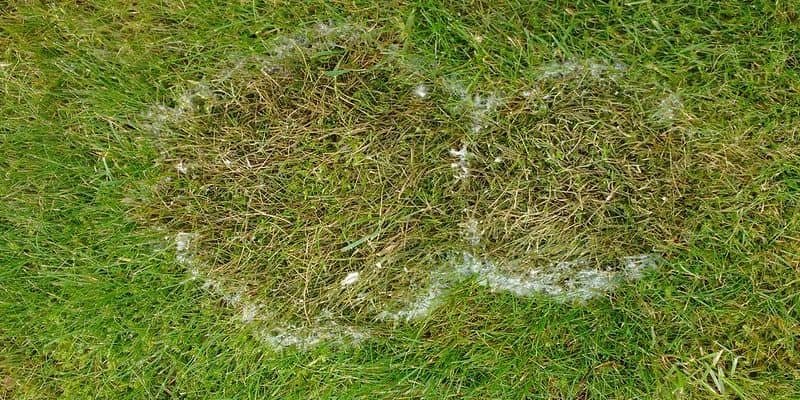
Causes:
- Caused by the fungus Microdochium nivale in wet, cold conditions without the need for snow cover.
- Often occurs in poorly drained areas or soils with low potassium levels.
Symptoms:
- Circular, tan to reddish-brown patches (4-8 inches in diameter).
- A slimy, matted texture on grass blades in damp weather.
- Affected patches expand if wet conditions persist.
Prevention:
- Drainage Improvement: Aerate compacted soils to enhance water movement.
- Balanced Fertilization: Apply potassium-rich fertilizers in fall to strengthen grass against fungal infections.
- Seed Selection: Use disease-resistant grass varieties, such as Kentucky bluegrass or perennial ryegrass.
Treatment:
- Apply fungicides with active ingredients like iprodione, fludioxonil, or chlorothalonil.
- Reapply fungicides every 2-3 weeks in persistently wet conditions.
Recommended Fungicides:
- Propiconazole 14.3
- Active Ingredient: Propiconazole
- Application:
- Rate: Apply 1-2 fl. oz. per 1,000 sq. ft.
- Method: Mix with sufficient water for uniform coverage.
- Frequency: Reapply every 14-21 days as needed.
- Note: Ensure thorough coverage of affected areas.
- Artavia™ 2 SC
- Active Ingredient: Azoxystrobin
- Application:
- Rate: Apply 0.38-0.77 fl. oz. per 1,000 sq. ft.
- Method: Dilute in water and apply evenly.
- Frequency: Reapply every 14-28 days, depending on disease pressure.
- Note: Provides preventive and curative action.
3. Pythium Blight (Grease Spot)

Causes:
- Caused by Pythium species fungi in waterlogged soils with poor drainage.
- Cool, wet weather (temperatures between 50-75°F) exacerbates outbreaks.
- Excessive nitrogen fertilization increases susceptibility.
Symptoms:
- Water-soaked, greasy-looking patches (1-4 inches in diameter) that expand rapidly.
- Slimy, cottony growth on grass blades during humid conditions.
- A musty odor often accompanies infected areas.
Prevention:
- Aeration: Aerate in the fall to prevent water pooling.
- Water Management: Avoid overwatering and correct drainage issues in low-lying areas.
- Nitrogen Balance: Apply fertilizers with controlled-release nitrogen to prevent overgrowth.
Treatment:
- Use fungicides containing mefenoxam, metalaxyl, or propamocarb.
- Remove and dispose of infected clippings to prevent fungal spread.
Recommended Fungicides:
Heritage® G Fungicide
- Active Ingredient: Azoxystrobin
- Application:
- Rate: Apply 2-4 lbs per 1,000 sq. ft.
- Method: Use a broadcast spreader for uniform application.
- Frequency: Reapply every 14-28 days as needed.
- Note: Water in lightly after application to activate the product.
Adrenalyn™ ETQ
- Active Ingredients: Azoxystrobin and Tebuconazole
- Application:
- Rate: Apply 1-2 fl. oz. per 1,000 sq. ft.
- Method: Mix with water and apply evenly.
- Frequency: Reapply every 14-28 days, not exceeding 6 applications per year.
- Note: Provides both preventive and curative control.
4. Powdery Mildew
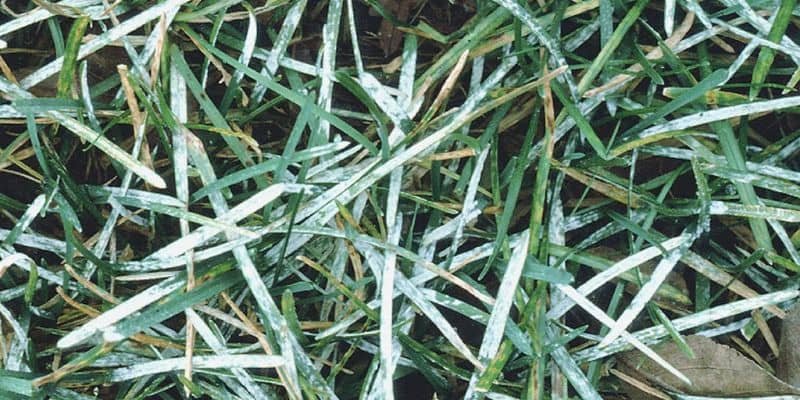
Causes:
- Caused by Blumeria graminis fungi in shady, cool, and humid conditions.
- Turfgrass grown in areas with poor sunlight exposure is most at risk.
Symptoms:
- White, powdery coating on grass blades, primarily in shaded areas.
- Blades turn yellow and weaken over time, leading to thinning turf.
Prevention:
- Increase Sunlight: Prune trees or shrubs to reduce shade on affected areas.
- Overseeding: Use mildew-resistant grass varieties such as fine fescue or tall fescue.
- Water Management: Water in the morning to allow grass to dry before nightfall.
Treatment:
- Apply fungicides with active ingredients such as sulfur, myclobutanil, or triadimefon.
- Reapply fungicide every 10-14 days if conditions persist.
Recommended Fungicides:
- Bonide® Copper Fungicide
- Active Ingredient: Copper Octanoate
- Application:
- Rate: Mix 0.5-2.0 fl. oz. per gallon of water.
- Method: Spray until foliage is thoroughly wet.
- Frequency: Repeat every 7-10 days as needed.
- Note: Apply at the first sign of disease.
- Spectracide® Immunox® Fungus Plus Insect Control
- Active Ingredient: Myclobutanil
- Application:
- Rate: Apply 6 fl. oz. per 1,000 sq. ft.
- Method: Use a hose-end sprayer for even coverage.
- Frequency: Reapply every 14 days as needed.
- Note: Controls both fungal diseases and listed insects.
5. Brown Patch
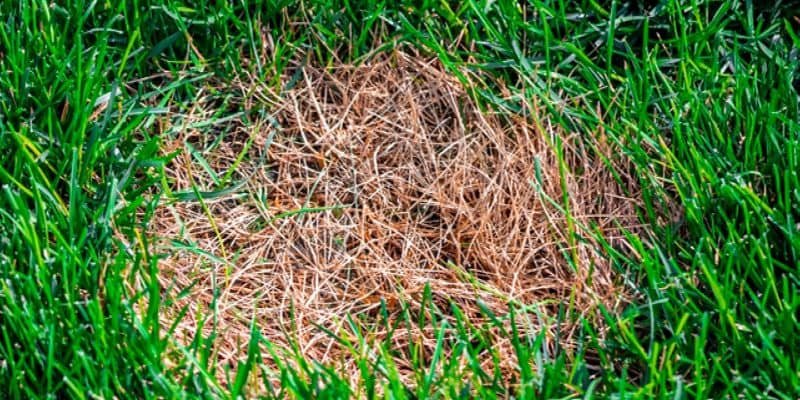
Causes:
- Caused by Rhizoctonia solani in wet and warm winter conditions, particularly in southern climates.
- High nitrogen levels and poor drainage exacerbate the disease.
Symptoms:
- Circular, brown patches (6 inches to several feet in diameter).
- Patches may have a dark “smoke ring” around the edges in the early morning.
- Grass within the patches becomes thin and brittle.
Prevention:
- Soil Aeration: Improve drainage by aerating compacted areas in the fall.
- Balanced Fertilization: Apply nitrogen carefully and avoid over-fertilizing.
- Water Management: Water deeply but infrequently to prevent excess surface moisture.
Treatment:
- Apply fungicides containing azoxystrobin, thiophanate-methyl, or flutolanil.
- Rake dead grass to stimulate regrowth and overseed bare patches.
Recommended Fungicides:
- DOW® Eagle 20EW Fungicide
- Active Ingredient: Myclobutanil
- Application:
- Rate: Apply 1.2-2.4 fl. oz. per 1,000 sq. ft.
- Method: Mix with water and apply uniformly.
- Frequency: Reapply every 10-14 days as needed.
- Note: Effective against a wide range of turf diseases.
- Lebanon® PPZ Fungicide
- Active Ingredient: Propiconazole
- Application:
- Rate: Apply 2-4 fl. oz. per 1,000 sq. ft.
- Method: Dilute in water and apply evenly.
- Frequency: Reapply every 14-28 days, not exceeding 16 fl. oz. per 1,000 sq. ft. per year.
- Note: Provides systemic disease control.
General Winter Lawn Care Tips
1. Manage Snow Cover
- Avoid piling snow in one spot; distribute it evenly to prevent prolonged moisture.
- Clear heavy snow from the lawn to reduce the risk of snow mold and grass suffocation.
2. Aerate and Dethatch in Fall
- Aerate compacted soil in late fall to improve drainage and oxygen flow.
- Dethatch to remove excess organic buildup that can trap moisture and encourage fungal growth.
3. Mow Strategically
- Gradually lower your mowing height before winter to reduce grass matting under snow.
- Keep the final mow around 2-2.5 inches to discourage fungal growth while protecting the crown of the grass.
4. Fertilize Wisely
- Use a balanced, slow-release fertilizer in early fall to strengthen grass roots.
- Avoid late-fall nitrogen fertilization, which can promote unwanted growth and disease susceptibility.
5. Keep the Lawn Clear
- Rake leaves and debris before the first snowfall to prevent suffocation and mold formation.
- Remove furniture, toys, and other items that could damage grass under snow.
6. Water Sparingly
- Stop watering as temperatures drop, but ensure the grass has enough moisture before the ground freezes.
7. Treat for Weeds
- Apply a post-emergent herbicide in late fall to eliminate any remaining broadleaf weeds.
- A weed-free lawn helps grass conserve nutrients for winter dormancy.
8. Watch for Winter Diseases
- Inspect your lawn for early signs of fungal infections like snow mold or brown patch after snow melts.
- Treat affected areas promptly with fungicides as recommended.
9. Plan for Spring
- Order seeds, fertilizers, and tools during winter to prepare for spring lawn care.
- Evaluate the lawn for reseeding or overseeding bare patches once temperatures warm up.
10. Limit Traffic on Dormant Grass
- Avoid walking on frozen or snow-covered grass, which can cause permanent damage.
- Redirect foot traffic with pathways or barriers to protect delicate turf.
Final words
Jake’s story is a reminder that winter isn’t the time to neglect your lawn. By taking these preventive and treatment steps, you can safeguard your lawn from common winter diseases and ensure a healthy, thriving turf come spring. Don’t let winter take its toll—stay proactive and give your yard the care it needs to thrive all year long.
